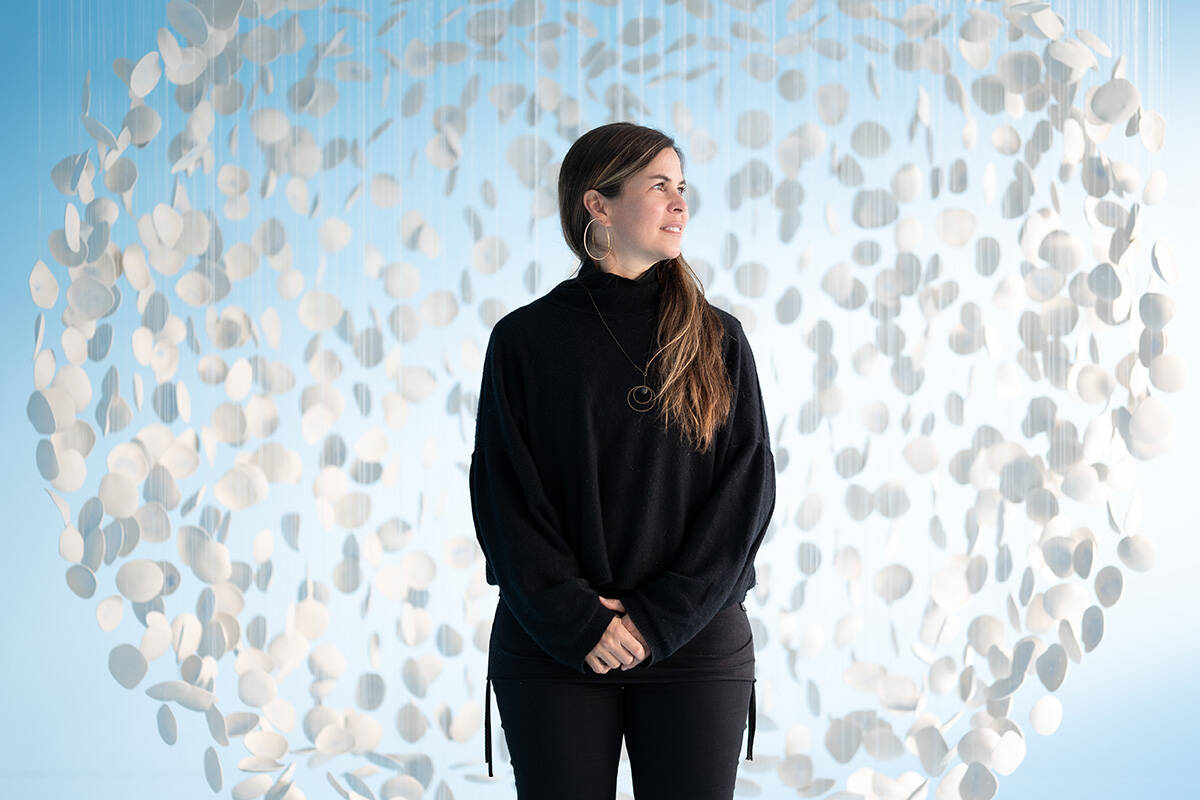– Words by Sean McIntyre Photographs by Lia Crowe
If mention of ceramics stirs images of clay pots, earthen mugs and country craft fairs, the work of Samantha Dickie is sure to provide a refreshingly new perspective.
The Victoria-based ceramic artist aims to recast perceptions of the art form while using the medium to promote a deeper, closer, more intuitive look at human existence and the myriad contrasts that make up the natural world. A tall order, no doubt, but it’s a mission Samantha has masterfully honed over more than two decades by attention to individual forms and how these pieces interact with one another.
During a walk-through of an exhibition called A Moment in Time featured at the Victoria Arts Council Gallery in October, Samantha explained how she seeks to inspire reflection among viewers. She likened it to a walking form of contemplative practice, wherein visitors to the gallery become participants who engage with the installations.
Her work is a study in contrast. Simple forms are cast within multitudes. A Moment in Time comprised four works with a total of more than 4,000 components. In one section of the exhibit, an enclosed closet-like space that was once a bank vault in the building’s previous life contained no fewer than 1,800 hand-shaped ceramic stones. Nearby, hundreds of sand-dollar-sized discs were suspended by translucent filaments of varying lengths to form a giant floating sphere. The cupped-shaped discs sat in opposition to one another like palms held apart in meditative pose.
“The pieces explored that etherealness, contemplation and pause,” she says. “It explored the concepts of spaciousness and how you can feel this inside yourself.”
Samantha explains how this particular installation was meant to highlight the “empty space” in between objects as much as it was a demonstration of the finely moulded ceramic elements.
In much the same way that the philosophical branch of phenomenology aims to identify the essence of natural phenomena and experience, Samantha’s work gives viewers the chance to pause and consider the relationships between sound and silence, objects and “empty” space, as well as the distinction between the built landscape and the natural world. It is this distinction and the varying degrees of transition between states, she says, that defines what it is to be human.
 “My belief that our humanness is essentially rooted in relational dynamics provides the impetus behind using scale and multiples to create large-scale, multi-component groupings and immersive installations,” she says.
“My belief that our humanness is essentially rooted in relational dynamics provides the impetus behind using scale and multiples to create large-scale, multi-component groupings and immersive installations,” she says.
Kegan McFadden, the curator of the A Moment in Time show, encapsulated the power of contrast and extremes in Dickie’s work in her curatorial statement for the October gallery exhibit.
“By playing with perspective and the phenomenological experience of moving through the gallery space, she forces viewers to confront how they observe space and what they perceive, and ultimately to question the way they experience her artwork,” he wrote. “Dickie’s work becomes cellular and its massive opposite, an elastic time line with no ending or beginning, a stratospheric excavation. It is at once micro and macro. This tension mirrors the reality that the nearly four thousand delicate ceramic components comprising these installations were made in the dangerously extreme, yet controlled, heat of her kiln. This is how pressure brings forth poetry.”
Samantha’s work hasn’t always been rooted in the philosophical, but a look over her career reveals that meaningful exploration of space, time and human existence has perhaps been the inevitable destination.
The artist launched her ceramics career in the late 1990s, soon after completing a degree in both women’s and Indigenous studies at Trent University in Peterborough, Ontario, and then trained as a technical ceramicist and obtained a Diploma of Ceramics from the Kootenay School of the Arts. An unrelenting curiosity and deep questioning of human existence, along with further research and reading into the fields of neuroscience, physics and philosophy, offer her the chance to use her passion for ceramics as a venue for deeper exploration of our world and human experience by focusing on abstract expressionism and minimalist sculpture within an installation practice.
“In 1997, my work began on the wheel creating one-of-a-kind functional and decorative pieces, and grew over the years into abstraction, sculpture and installation,” she writes on her website. “Early sculptural work includes explorations of scale; of gouging and imprinting the clay; of multi-layered textural glazes; and of reduction, smoke and wood firing.”
Samantha’s work has since been exhibited and sold in galleries across Canada and the United States. Her works have been shown under the open Yukon sky and are featured in prestigious retail spaces that include a Louis Vuitton boutique in Boston. As if constructing intricate sculptural works wasn’t complex enough, this fall she was working on the logistics of shipping three six-foot-tall sculptures for permanent display in Hawaii. Amidst the greater awareness of her work in faraway places, Samantha says, it’s been great to be a part of the local scene here in Victoria. Just last year, for example, the Art Gallery of Greater Victoria acquired a work titled The Gesture of Grace, one of the gallery’s larger sculptural pieces.
Samantha’s rising profile has included being invited to give an increasing number of online and in-person artist talks and workshops, offering her the chance to share her uniquely modern take on a traditional art form to a wider audience.
Her next exhibition opens at Victoria’s Fortune Gallery (537 Fisgard Street) on February 17. Her work can also be found locally at the Madrona Gallery or by booking an in-person visit to her studio through her website: samanthadickie.com.
Story courtesy of Boulevard Magazine, a Black Press Media publication
Like Boulevard Magazine on Facebook and follow them on Instagram

